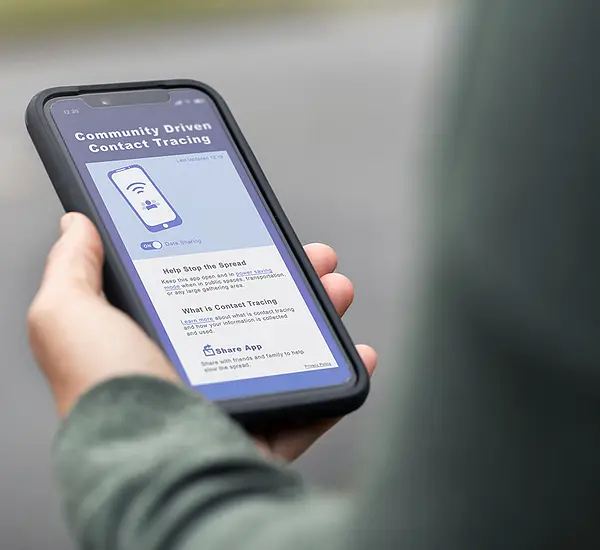First responders face increased risk of exposure to SARS-CoV-2, the virus that causes COVID-19. In September 2020, the United States Fire Administration (USFA) declared COVID-19 as the leading cause of U.S. firefighter fatalities. Current projections continue to show increases of illness and death: Line-of-Duty-Deaths (LODD) across all public safety groups are expected to double by the end of the year.
Close public contact is an everyday part of public safety occupations. Exposures can occur across a range of activities, including medical and non-medical calls for service, public assistance encounters, interactions with healthcare workers, and extended periods of time on-shift, living in close quarters with other crew members. Further increasing their risk, firefighters are the public safety group who are least likely to wear masks indoors, despite overwhelming evidence that masks reduce transmission risk.
First responders are accustomed to strict use of Personal Protective Equipment (PPE) in the line of duty to protect themselves from hazards in the workplace, including infectious disease exposure. As local, state, and national authorities work to innovate COVID-19 solutions and modernize our nation’s public health infrastructure, a new category of protective resources is emerging: Digital PPE.
Digital PPE refers to the use of connected devices, including smartphones, smartwatches, or other wearables to support traditional public health response. Examples of Digital PPE include smartphone- or wearable-based exposure notification systems and the use of wearables for presymptomatic risk assessment or disease detection.
In the past three months, 16 states have released free exposure notification smartphone applications (apps) available on the Android and Apple app stores. These apps can help track proximity of individuals to one another and send an alert if users have been near someone who tests positive for COVID-19. All states’ exposure notification apps have been built using resources created by Google and Apple that can only be accessed by developers working on behalf of a recognized Public Health Authority. Designed to protect personal data privacy, these apps do not collect location data or any personally identifiable information. Instead, the apps use Bluetooth technology to exchange anonymous information with other smartphones and create a temporary, two-week record of “close contacts.” Close contact is defined as having been within 6 feet (of a person who doesn’t live in your household) for at least 15 minutes, over 24 hours. If a user tests positive for COVID-19 and shares their results in the app, a broadcast notification is sent to close contacts in the temporary record, alerting them to the potential exposure and providing follow-up instructions and access to additional resources.
These apps are free, readily available in the Google and Apple app stores, and can be set up in minutes. Once installed, the app runs quietly in the background and does not require any input during monitoring. If a user tests positive for COVID-19, they can anonymously share their test result to notify close contacts with one click. Table 1 (below) shows a list of all states that have released a COVID-19 contact tracing app and provides links to more information from each state authority and links to download the apps for both Android and iOS.
Simulations and other models of COVID-19 transmission have shown that the use of an exposure notification application, if carefully implemented alongside other measures, has the potential to substantially reduce the number of new coronavirus cases. These models show that adoption of these technologies at any level of uptake can have a protective effect.
For all states where these apps are available, there is an immediate opportunity: promote the use of COVID-19 exposure notification apps by first responders as Digital PPE. Agencies and departments that utilize these apps could provide protective benefits to their responders and the communities they serve by providing continuous exposure monitoring during calls for service and while personnel are in quarters.

For all states where these apps are available, there is an immediate opportunity: promote the use of COVID-19 exposure notification apps by first responders as Digital PPE.
Agencies and departments that utilize these apps could provide protective benefits to their responders and the communities they serve by providing continuous exposure monitoring during calls for service and while personnel are in quarters.
In November 2020, RTI International partnered with the North Carolina Office of the State Fire Marshal to conduct a survey of 1,107 fire departments across the state to assess awareness of the NC Department of Health and Human Services SlowCOVIDNC app and organizational readiness to adopt Digital PPE. Results will be used to inform a targeted communications campaign to encourage app uptake by departments and first responders.
Demonstration projects in the states that offer Digital PPE could ultimately inform a more coordinated, national strategy for protecting first responders. Existing COVID monitoring initiatives for firefighters (e.g., the International Association of Fire Fighters (IAFF), U.S. Fire Administration (USFA), and National Institute for Occupational Safety and Health (NIOSH)) have been limited by the lack of standardized reporting. These apps could reduce the administrative burden of outreach and communication during an exposure event by automatically delivering alerts to first responders who may have been exposed to COVID-19. They could also be used by departments in support of workers’ compensation filings or in support of LODD reporting. National adoption may be considered as part of the COVID-19 response strategy of the incoming Biden-Harris administration. Such a policy could lead to successful adoption by first responders.
LODDs across all public safety groups are projected to double in 2020 due to COVID-19. The early adoption of Digital PPE by first responders in 16 U.S. states provides an important opportunity to explore new ways to improve accuracy of tracking COVID while enhancing protections for emergency services personnel.
Additional Resources
Table 1. Contact-Tracing Application Information by State
App-Name: GuideSafe
App-Information from State Authority
| iOS App Store Link | Google Play Link |
App-Name: Covid Watch Arizona
App-Information from State Authority
| iOS App Store Link | Google Play Link |
App-Name: CA Notify
App-Information from State Authority
|
|
App-Name: CO Exposure Notifications
App-Information from State Authority
| [Enabled in iPhone Exposure Notifications Settings] | Google Play Link |
App-Name: COVID Alert CT
App-Information from State Authority
| [Enabled in iPhone Exposure Notifications Settings] | Google Play Link |
App-Name: COVID Alert DE
App-Information from State Authority
| iOS App Store Link | Google Play Link |
App-Name: DC CAN
App-Information from State Authority
| [Enabled in iPhone Exposure Notifications Settings] | Google Play Link |
App-Name: MD COVID Alert
App-Information from State Authority
| [Enabled in iPhone Exposure Notifications Settings] | Google Play Link |
App-Name: MI COVID Alert
App-Information from State Authority
| iOS App Store Link | Google Play Link |
App-Name: COVID Trace Nevada
App-Information from State Authority
| iOS App Store Link | Google Play Link |
App-Name: COVID Alert NJ
App-Information from State Authority
| iOS App Store Link | Google Play Link |
App-Name: COVID Alert NY
App-Information from State Authority
| iOS App Store Link | Google Play Link |
App-Name: SlowCOVIDNC
App-Information from State Authority
| iOS App Store Link | Google Play Link |
App-Name: Care19 Alert
App-Information from State Authority
| iOS App Store Link | Google Play Link |
App-Name: COVID Alert PA
App-Information from State Authority
| iOS App Store Link | Google Play Link |
App-Name: COVIDWISE
App-Information from State Authority
| iOS App Store Link | Google Play Link |
App-Name: Care19 Alert
App-Information from State Authority
| iOS App Store Link | Google Play Link |
+ Oregon, South Carolina, and Washington have apps currently in development
*Alaska, Arkansas, Florida, Georgia, Hawaii, Idaho, Illinois, Indiana, Iowa, Kansas, Kentucky, Louisiana, Maine, Massachusetts, Minnesota, Mississippi, Missouri, Montana, Nebraska, New Hampshire, New Mexico, Ohio, Oklahoma, Rhode Island, South Dakota, Tennessee, Texas, Utah, Vermont, West Virginia, and Wisconsin do not have apps available

